- New 308 PHEV vs rivals
- Can it topple VW and Mercedes?
- And can it make plug-ins fun?
Peugeot’s slick new 308 is available as a plug-in hybrid. Does it do fun with frugality better than Merc or VW?
Pre-flight briefing: Peugeot 308 Hybrid 225
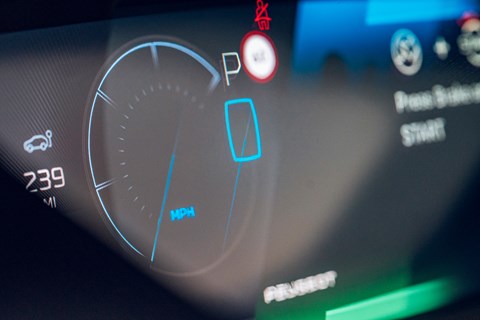
Why is it here?
Peugeot’s first plug-in hatchback is the avant-garde challenger to German PHEV hegemony. This latest 308 promises to bring flair to a slightly dull segment – Peugeot’s already excellent current 508, 208 and 2008 laid the groundwork, and we liked the previous 308, so on paper it’s a strong contender.
Any clever stuff?
It’s still on the EMP2 platform, but while Peugeot has offered petrol, diesel and electric models in one body style before, this is the first time it’s thrown a plug-in hybrid into the mix. No other car covers as many bases. i-Cockpit infotainment also gets a refresh, with a pair of 10-inch screens for higher specs.
Which version is this?
It’s the Hybrid 225 in top-spec GT Premium trim. A Hybrid 180 is also available, but both use a 1.6-litre turbo four, a 12.4kWh battery and an eight-speed gearbox. An on-board 3.7kW charger is standard, with 7.4kW available as an option – you’ll need that to achieve the quoted charging time of 115 minutes.
Read our Peugeot 308 review
Pre-flight briefing: VW Golf eHybrid
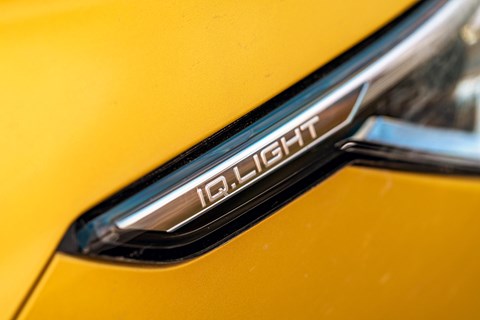
Why is it here?
The Golf is the class benchmark, the base model is a fixture in UK top-10 best seller lists (sixth last year), and the Style eHybrid is built to ace PHEV benefit-in-kind rules. The Mk8 debuted in 2019, keeping the MQB platform but evolving the Mk7’s design and engineering, with larger steps for in-car tech.
Any clever stuff?
VW is particularly proud of the Wi-Fi-based Car2X tech. If other cars and infrastructure with Car2X note a hazard – traffic jams, prangs etc – they ping a message if you’re within 800 metres. Innovision Cockpit infotainment with twin 10-inch digital displays is also standard across the range; a bit glitchy though. Excellent IQ. Light LED matrix headlights are an option.
Which version is this?
Have an eHybrid in any trim you like so long as it’s Style, though the more potent GTE is also available. eHybrid combines a 1.4-litre turbo petrol engine with a 13kWh battery. VW states 173 minutes to charge to 100 per cent on a 3.6kW wallbox.
Read our VW Golf eHybrid review
Pre-flight briefing: Mercedes A250e
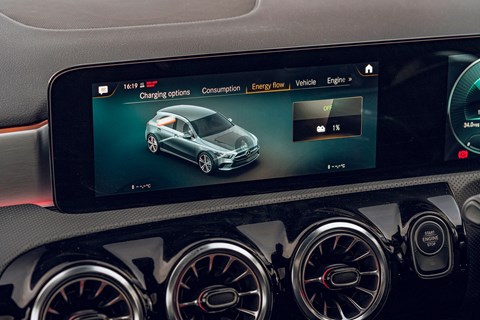
Why is it here?
The A-Class beat the Golf in UK sales charts last year, plus it was the UK’s second best-selling PHEV, behind only the 3-series. Still a benchmark for its MBUX infotainment, and hits all its BiK targets, including dropping below £35k in lesser trims, and claims best e-range (44 miles) from smallest battery. Formidable on paper.
Any clever stuff?
Definitely MBUX, especially its Alexa-like voice control, which helps seal best-on-test infotainment status. Less flashily, the exhaust stops in the middle of the car near the rear axle, helping reduce impact on boot space from hybrid batteries. Smallest boot here, though, so maybe it’s not all that clever…
Which version is this?
AMG Line Premium Plus. Alongside the 1.3-litre turbo four and 10.6kWh battery, the toppy trim gets you the full MBUX twin 10.25-inch screens, AMG bodykit and 18s, plus multi-beam LED headlights. A 7.4kW on-board AC charger is standard, allowing 0-to-100 per cent charging at a 7.4kW wallbox in around 90 minutes.
Read our Mercedes A250e review
Formula PHEV: 308 vs Golf vs A-Class PHEVs
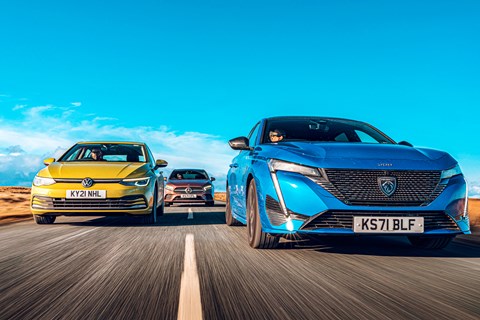
Imagine if CAR challenged Adrian Newey, Gordon Murray and Patrick Head to each design a plug-in hybrid for a road-legal race series. We could call it Formula PHEV, and it would have two rules: the cars must be tax-efficient, and the final of this one-round series would be held on the roads of Yorkshire.
Formula 1’s technical holy trinity would surely go bananas, even though their creations would have to be priced under £35k, allowing purchasing businesses to reclaim 18 per cent as a first-year capital allowance. CO2 would have to be below 50g/km because taxation makes a big step above that. And the electric-only range would preferably be above 40 miles, because then the company car driver’s benefit-in-kind (BiK) tax drops to just eight per cent, versus circa 30 per cent for a BMW 320d.
Clearly Newey and co did not design the Peugeot 308, Volkswagen Golf or Mercedes-Benz A-Class PHEVs, cars created with these criteria in mind. And instead of the streamlined teardrops of my dreams, all are front-wheel-drive five-door hatchbacks. All are powered by a small turbocharged four-cylinder engine assisted by an electric motor and small lithium-ion battery. All weigh around 1600kg. Yep, 1600kg. All can drive for around 40 miles and reach motorway speeds on zero-emissions electric power and also record well over 200mpg on the WLTP test. Finally, all have flashy double infotainment screens that are a little troublesome to fathom. It’s uncanny.
Thing is, despite such technical homogeneity, each of our test cars puts its own highly distinctive twist on Formula PHEV, making the three options before us quite different ownership propositions.
To explore further, CAR is de-camping to the Yorkshire Moors, to find out which PHEV is most enjoyable to drive, and to test fuel economy. We’ll do an electric run to record the max e-range, another 80 miles of 70mph-ish cruising to get a fuel economy figure in hybrid mode (starting with a full electric charge), and an overall economy figure over a longer distance that’s more representative of someone charging only infrequently and bunging a fuel card through on expenses.
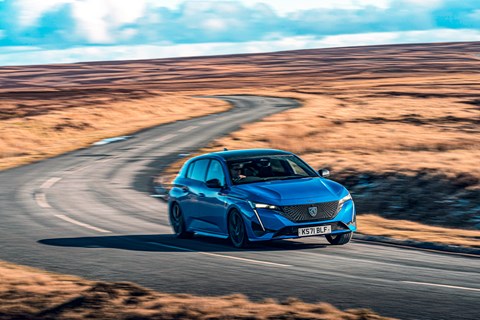
Like its very good predecessor, the new 308 uses the EMP2 platform with pseudo MacPherson strut suspension up front and a torsion beam at the rear. Squint and the proportions and detailing are familiar, but eyes wide it’s like the design’s been sharpened on a whetstone, then embellished with distinctive LED jewellery. There’s an extra 55mm to the wheelbase. Two 308 PHEVs are available, with our Hybrid 225 technically near-identical to the less potent Hybrid 180, which offers no real improvement in range or CO2. Both combine a largest-on-test 1.6-litre four-cylinder engine with a 12.4kWh battery that’s just a smidge smaller than the Golf’s 13kWh, and bigger than the Merc’s 10.6kWh lump.
Whirl our 225’s electricity and petrol together and you get a best-on-test 222bhp with a worst-on-test 266lb ft (despite each car’s engine producing an identical 184lb ft, showing that the 308’s e-motor contributes less). WLTP figures reveal the 308 can’t go as far as the others on e-power at 39 miles, and has the lowest claimed mpg, at a still unlikely-to-be-achieved 235mpg…
This leaves the 308 subject to 12 per cent benefit-in-kind tax compared with eight per cent for the others (for cars priced around £35k, that’s a £500 or so penalty for a company-car driver paying 40 per cent tax). Our test car is also the top-spec GT Premium, which busts through the ideal sub-£35k base price – only the Hybrid 180 ducks below.
The numbers are against the Hybrid 225 GT Premium, but boy does it work to make amends. Its interior more than delivers on expectations heightened by the exterior. There’s such a sense of occasion, with hidden-until-lit infotainment buttons ghosting from piano-back trim, soft-touch plastics higher up, and a substantial-feeling knurled finish for key switchgear. Angular flourishes of the instrument panel and centre console do eat away at the sense of space, but I’m perfectly comfortable – the seats in particular are exceptional, giving just a little as you sit down and moulding around you. Beware that only GT Premium spec gets these chairs, though.
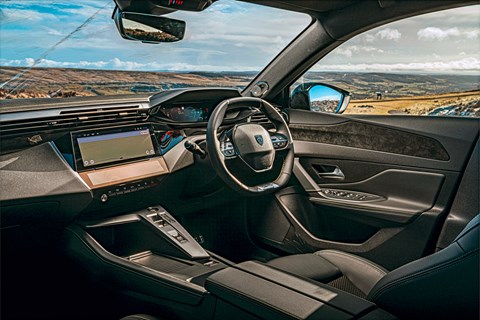
A tiny steering wheel and digital i-Cockpit are familiar, but updated with a central 10-inch touchscreen plus another ahead of the steering wheel. Unfortunately the 10-inch 3D instrument binnacle is pretty like a kaleidoscope rather than useful. I’ve got more chance landing a 737 on instruments than working out what’s occurring.
I like driving the 308. It feels taut, precise and incredibly direct, the promise of driving fun to come, with only an inconsistent, soft-ish brake pedal knocking the sheen off (the bane of electrified cars that rely on regen braking to charge batteries), and we soon settle to a comfortable cruise up the A1 – road noise is a whisper, leaving only distant wind noise, and the ride on passive dampers has lovely pliancy and control. Even if the 18-inch rubber does nibble low-speed imperfections, it never irritates.
Hybrid mode switches between power sources often imperceptibly at a cruise, and everything’s smooth if you’re gentle with the throttle. A lovely cruiser, then, but performance is middling, and the refinement gives way to a thrash if you floor the throttle, at which point gears spin about on the dash like a fruit machine, and there’s a clumsy torque impulse after every upshift in Sport mode. It’s the driving equivalent of out-of-phase lip-sync.
Later, on the Moors, it’s a load of fun, and could handle much more power. The steering’s not particularly talkative, but it’s quick and precise, jinking keenly off-centre like a featherweight boxer ducking the punches. No other front end bites so positively, the rear end is nicely adjustable, and there’s excellent body control and compliance to dance over the landscape. Bring on the GTI.
The day before, we squeezed 27 miles of electric range from the Peugeot, and as I pull in to Ferrybridge services to meet Alan Taylor-Jones in the Golf, I note this morning’s hybrid economy at an impressive 64.2mpg. Alan’s trumped that with 31 miles and a hybrid average of 67.3mpg in the Golf eHybrid. Later, the Golf cements its superiority by recording 45.4mpg over 200 mostly petrol-powered miles, besting the 39mpg of rivals. Yes, a lot.
Compared with the 308’s reinvention, the Golf Mk8 looks like the previous generation at a masked ball, wandering about mysteriously with new headlights on a stick thinking no one’s twigged who it is. Only the 26mm extra length is notable – the rest would glide through a Tesla factory as production tolerances. Indeed, under the skin a Mk8 is very similar to its predecessor, still built on the MQB platform with MacPherson strut suspension at the front and – because this is a Golf with more than 148bhp – a more sophisticated multi-link rear end.
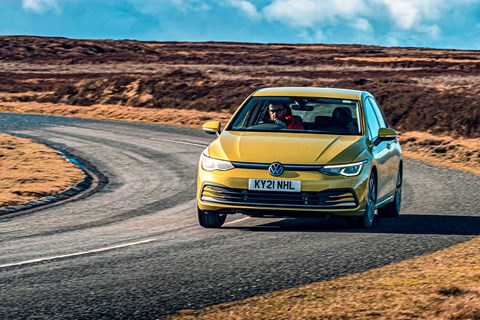
Unlike Peugeot, VW’s not new to plug-in hybrid hatches, originally launching with the Mk7 GTE. You can buy a Mk8 GTE, but the eHybrid is the hot benefit-in-kind ticket. Available only in Style trim, it ticks its BiK boxes like a gunslinger shooting bottles off a wall: £33,585 price of entry, 43-mile e-range and 21g/km CO2, bang, bang, bang, efficiency helped by an improvement in aerodynamic slickness to an exceptional 0.275 Cd.
Stepping inside the Golf is like going on holiday, provided your holiday starts at the rental car kiosk. It’s stark, but feels calm, soberly designed and well built. James ⊲ Taylor praises the ergonomics, the sight lines, the adjustability of the driving position. The seats are exceptionally comfortable and nicely supportive, and you can drop ’em right on the deck. The rear seats are significantly more accommodating than the 308’s (and a bit better than the Merc’s). Good old Golf – already wooing us with logic.
Ah, save for the infotainment. The Innovision Cockpit has come in for much flak, but I was about to say it wasn’t a deal-breaker… until it glitched right before I handed it back. Still, the dials are far crisper and easier to decipher than the 308’s, I like the simplicity of choosing Hybrid or EV mode (with Eco, Comfort, Sport, Individual settings for both) and when it worked we got on well enough.
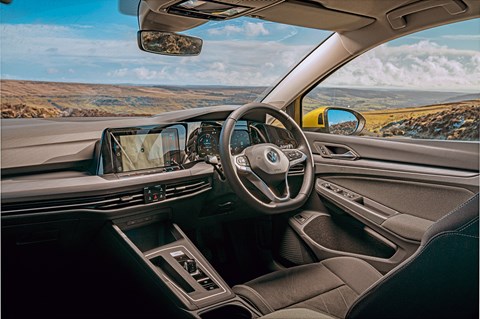
On the A1, the Golf feels poles apart from the 308, with ride quality the stand-out – supplied on (CO2-friendly) 16-inch alloys and optional adaptive dampers with 15 settings on a slider like a ’80s graphic equaliser, it is deliciously supple in its softest setting. One of the best-riding cars I’ve ever driven, in fact.
There’s a vanilla consistency smeared all over the steering, pedals (brake feel is better than the others, but still iffy) and gearshifts, complemented by high levels of rolling refinement, and an engine that slips nicely between hybrid and e-mode when you tickle the throttle.
The road gets more interesting near Thirsk, but the Golf doesn’t so much rise to the occasion as stroll over the topography like a head teacher through a school disco. You can stiffen the steering and suspension, and it gets into a fluid rhythm, helped by its exceptional ride comfort and consistently weighted controls, but it’s not engaging, it scrubs softly into understeer and starts to feel busy underfoot when you really shift.
No, it’s the powertrain that irks when I dig deeper into its reserves, which you’ll need to do if you’re to get a move on. There’s some vocal thrashing at heavy throttle, and the gear mapping is more troublesome in Sport – it’s an old-school six-speed dual-clutch here (the others get eight speeds), and twice it dropped to first when I was already up to a decent speed after stopping at a roundabout. At least you can take more complete manual control of it than the 308, but a basic petrol Golf with a manual gearbox would be way more fun and intuitive.
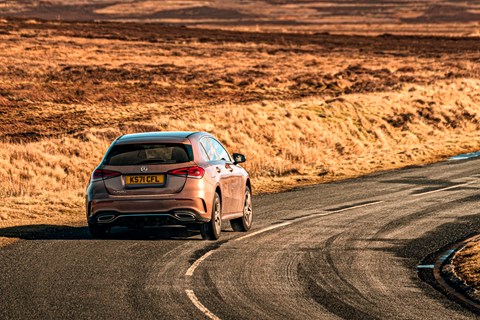
We meet Tim Pollard at the top of the Moors with the A250e in AMG Line Premium Plus, for £38,280. Entry-level AMG Line trim sneaks the same mechanical spec below the £35k ceiling. The Merc’s managed a test-best of 32 miles of pure-electric range, and 49.6mpg on a hybrid run, against an official 44 miles and 256.8mpg. Tim charged before he set out and ran along mostly dual carriageway at 70mph-ish in light traffic using Comfort mode, much as we did, so it’s a puzzling difference.
The interior looks sensational with its jet-engine-like air vents and pleasing mix of piano-black trim, anodised inserts and faux suede/leather, although cheaper plastics are deployed lower down, and the seats are unnecessarily firm and tight. The halo over it all is the MBUX infotainment system – here with twin 10.25-inch back-to-back screens for the full widescreen experience.
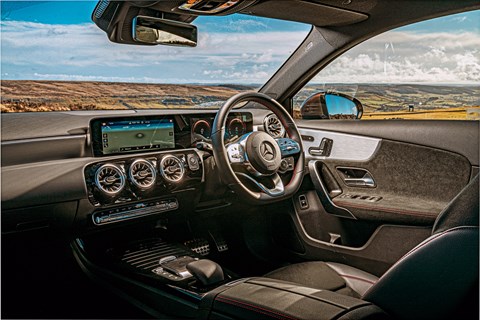
You learn to flick through functions on the trackpad or touch-sensitive steering wheel, and much of that’s made obsolete by the excellent ‘Hey Mercedes’ voice control. Imperfect, yes, but best here by a large margin.
At 1.3 litres, the A-Class engine is group tiddler, and promises the highest emissions-free range at 44 miles. Yet it almost matches the Peugeot with a petrol-electric combined 215bhp, and thumps its rivals with an all-hands-to-the-pump 332lb ft. You feel its extra urgency, though hard throttle use is accompanied by a sucking noise, somewhere between a fatal catfight and flushing the toilet on a plane. It’s pretty rowdy at a cruise too.
The chassis works well enough during most driving. There’s just the one damper setting and it’s pretty soft, so it breathes with the road and I even quite enjoyed it point-to-point over the Moors, but motorway expansion joints can thunk into the cockpit like asteroids battering the Starship Enterprise, and if you’re really late for a meeting, it starts to twist like the Tacoma suspension bridge in a gale. At least the limit understeer is predictable and progressive enough to lean on. The A250e is mostly soft and comfortable, and does a decent enough job point-to-point – except again for a hard-to-modulate brake pedal.
These are three very similar cars on paper, then, but after a hard day’s testing their very distinct strengths and weaknesses make them easy to split on paper…
Second opinion: Tim Pollard
To sit in the A-Class is to be transported to a sector far, far away. It combines dramatically sweeping digital screens, complicated touchpads and brilliant voice control. That ‘Hey Mercedes’ natural speech recognition means you can talk to your car without recourse to fiddly menus.
The interior is smarter than the way it drives: in many regards, this is an unremarkable family hatch, though the A250e’s e-range impresses and doesn’t gobble up all the kWh on the motorway, instead preserving volts for its next urban excursion.
Second opinion: James Taylor
I think the 308’s interior looks fantastic, with a direct thread to concept cars as far back as 2014’s Quartz. But I’m not convinced it works all that well. The 3D instrument panel’s busy design is fatiguing on a long journey, and while I love the configurable shortcuts at the base of the touchscreen, adjusting the air-con, for example, still demands too much eyes-off-the-road time. Overall, it’s a lovely car with real style, intelligent use of interior materials and a bolder feel than its rivals. I like it; I just wish it was less annoying.
308 vs Golf vs A-Class PHEV: the final reckoning
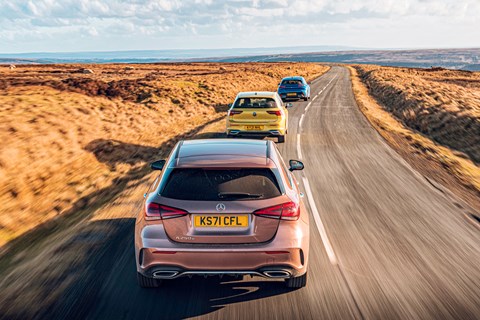
Indulge me two general observations before we cut to the chase. Firstly, these PHEVs are in some ways more satisfying than their conventional siblings for general pottering about (courtesy of refinement and the feelgood factor of saving fuel), but they become less satisfying the harder you drive (blame their weight and thrashy power- trains). Secondly, their fuel-saving potential is highly user-dependent, but charge them daily for short trips and you can smash the official figures, and round trips of up to 80 miles can be achieved very efficiently indeed.
Third place goes to the Mercedes, with its exceptional MBUX infotainment system and strikingly premium interior. It’s faster than the others, still turned in some decent real-world economy figures, recorded marginally the best e-mode figure, and hits its BiK targets. But it’s not as good to drive as the Peugeot, can’t match the Golf for ride quality (the VW was on optional adaptive dampers, mind), and falls short of both on refinement.
The Golf nails all the company-car checkpoints with its price, emissions and e-range, makes decision-making easy by coming in just one spec (to which you can add a couple of key options before breaking through the £35k ceiling), and makes for a comfortable, spacious, refined and highly practical way to get about. Weighed with a sensible head, this is the best all-rounder, a car I’d happily rely on every day, which might make it your number one.
But I’d take the Peugeot. Despite an at times frustrating lack of control over what the gears are up to, there’s no question the 308 is the most engaging car. It has striking exterior design and avant-garde interior, and it’s highly refined and comfortable at a cruise, both in terms of ride comfort and powertrain machinations. It also turns in very impressive real-world economy figures.
This is not a clean sweep for the 308, however. Very substantial downsides include tight rear seats, the extra four per cent of benefit-in-kind it attracts, its only moderate performance, and that you’ll need the less powerful Hybrid 180 model to scrape under £35k. Much of this stuff is between you, a calculator and whoever has to sit in the back, and we’d point you to the Golf if this amounts to irreconcilable differences. For us, though, the Peugeot 308 is Formula PHEV champion 2022.
308 vs Golf vs A-Class PHEV: the verdict
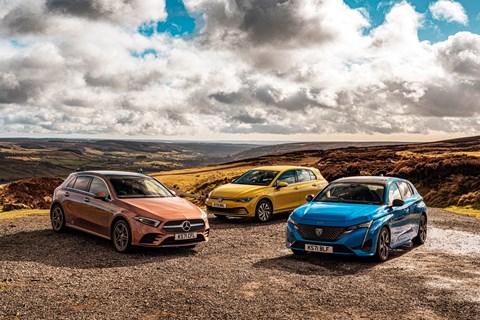
First place: Peugeot 308
Best to drive, refined at a cruise, and brings real design flair. Tight in back, efficiency figures not quite on-point
Second place: Volkswagen Golf eHybrid
The all-round choice. Nails price and efficiency numbers, plus it’s practical and comfy
Third place: Mercedes-Benz A250e
Fantastic interior, best infotainment and performance, mostly comfy ride. Noisy and unrefined at times